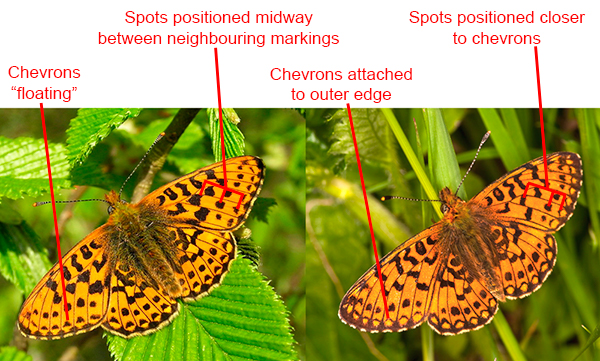This page list those pairs of species that are most often confused with one another. This list is ordered by the vernacular name of the first species.
The female Adonis Blue is easily mistaken for a female Chalk Hill Blue and the two species occasionally fly together toward the second half of August on some sites. Distinguishing the two is not at all easy. One guideline is that the pale scales on the hindwings, between the red lunules and the white fringe, are blue in a female Adonis Blue, and white in a female Chalk Hill Blue.
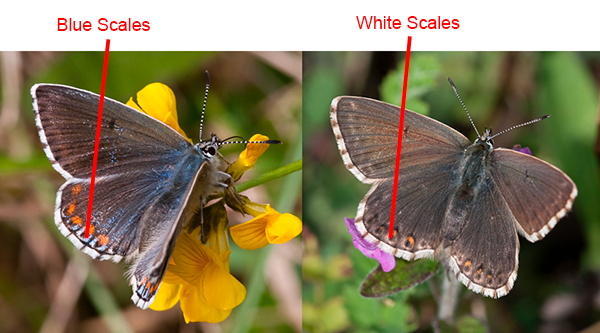
The male Adonis Blue is often mistaken for a male Common Blue. However, the two can be distinguished by looking at the white fringes of the wings. Only on the Adonis Blue are the fringes intersected by black bands. This diagnostic can also be used to distinguish the two species based on their undersides.
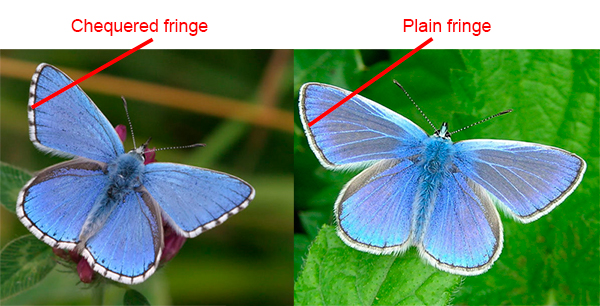
Of the three species of Clouded Yellow found in the British Isles, the Clouded Yellow is both the commonest and the easiest to identify. When in flight, the orange appearance of the Clouded Yellow is unlike any other British butterfly. When settled, the lemon-coloured underside of the Clouded Yellow allows us to distinguish this species from Berger's Clouded Yellow which has a much paler underside. This diagnostic holds true even in the helice form of female Clouded Yellow where the orange colouring is replaced by a creamy white.
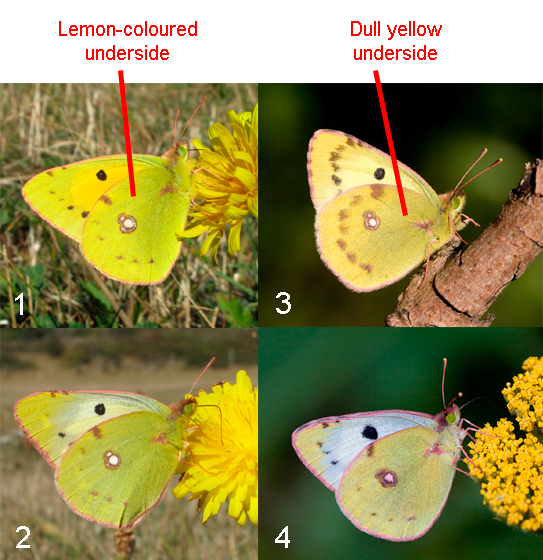
Distinguishing Berger's Clouded Yellow and Pale Clouded Yellow is not at all easy and the identity of a given individual can only be reliably determined if it has been raised from the larval stage when the difference between these two species is obvious. However, there are some general rules of thumb that can be applied to the adults and a combination of these can give an indication of the species. Unfortunately, all of these diagnostics are comparitive and, unless you are familiar with both species, can be difficult to judge with any certainty. The first diagnostic is with respect to wing shape, where the Pale Clouded Yellow has a more pointed apex to the forewing than that of Berger's Clouded Yellow. The other diagnostics are only applicable if the upperside is visible. Given that all of the clouded yellows settle with their wings closed, the only way to get a good view of the upperside is to catch the individual in order to examine it (which should not be attempted unless you are certain you won't harm it). The second diagnostic is that the orange spot found on the upperside of the hindwing is brighter in the Berger's Clouded Yellow than the Pale Clouded Yellow. The final diagnostic concerns the dusting of grey scales found on the forewing upperside next to the body. This patch of grey scales is a more-extensive in the Pale Clouded Yellow than the Berger's Clouded Yellow.

Both Black Hairstreak and White-letter Hairstreak are very local species, but do fly together on rare occasions. There are two features that distinguish these species. The first is that the Black Hairstreak has a row of distinctive black dots running along the inside of the orange band on the underside of the hindwing, that is absent in the White-letter Hairstreak. The second is that the White-letter Hairstreak has a more pronounced white line on its hindwing, forming a letter "W" from which the White-letter Hairstreak gets its name. This line is less prominent in the Black Hairstreak.
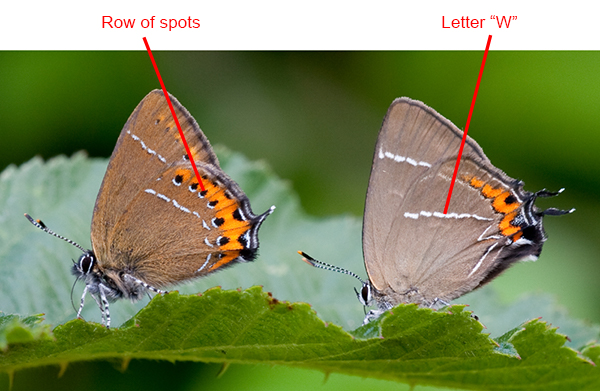
Of the two sexes, it is the female Common Blue that causes most confusion with the Brown Argus. The blue present in a female Common Blue is highly variable, with individuals ranging from almost completely blue through to completely brown. It is this latter colouring that causes the most confusion. Even so, the Brown Argus has no blue scales, but may give off a blue sheen from the wings and the hairs found on the thorax and abdomen. Another diagnostic is that the Brown Argus normally has a prominent dark spot in the centre of the forewings. A long and thin abdomen also indicates that the butterfly is male and can only, therefore, be a Brown Argus.
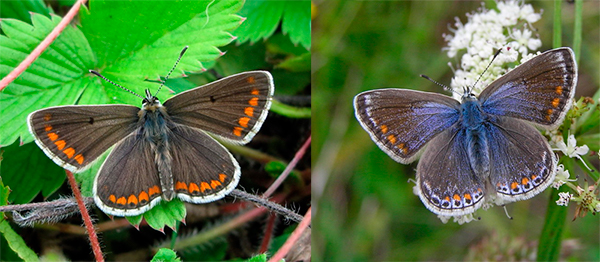
Differentiating Brown Argus and Common Blue from their undersides is more problematic, and we need to resort to the pattern of spots. Here we have two distinguishing features. The first is that the Common Blue has a spot on the underside of the forewing that is absent in the Brown Argus. The second is that two of the spots on the leading edge of the hindwing are relatively-close in the Brown Argus, almost forming a "figure of eight", but are more spaced apart in the Common Blue. This diagnostic is particularly useful if the underside of the forewing isn't visible.
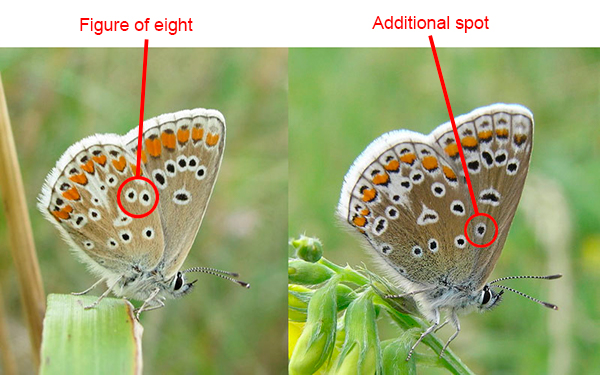
Although very similar in appearance, the Brown Argus and Northern Brown Argus can be separated by location. However, this situation may change with global warming as the Brown Argus moves further north.
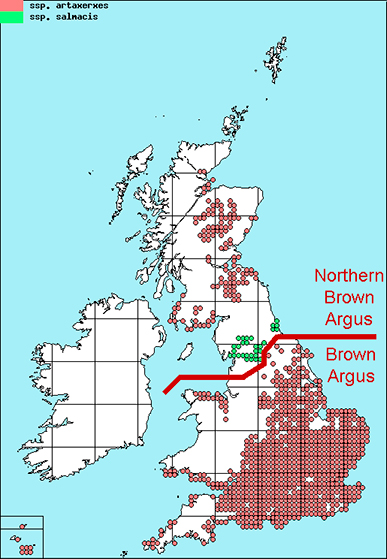
Of the three species of Clouded Yellow found in the British Isles, the Clouded Yellow is both the commonest and the easiest to identify. When in flight, the orange appearance of the Clouded Yellow is unlike any other British butterfly. When settled, the lemon-coloured underside of the Clouded Yellow allows us to distinguish this species from Pale Clouded Yellow which has a much paler underside. This diagnostic holds true even in the helice form of female Clouded Yellow where the orange colouring is replaced by a creamy white.
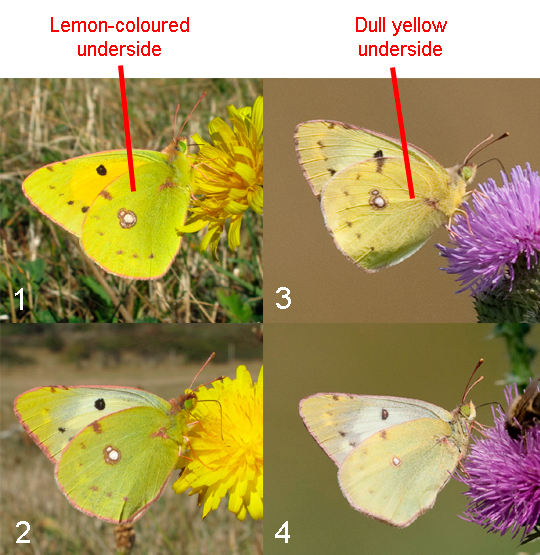
The Common Blue male and Holly Blue are occasionally found in the same habitat and, even when in flight, it is possible to distinguish these two species since the Holly Blue will tend to fly at head height, whereas the Common Blue always remain relatively close to the ground. The Holly Blue is also the more likely of the two species to be encountered in suburban gardens where the primary larval foodplants of Holly and Ivy abound although this is also a general rule of thumb. When settled, it is easy to distinguish the male Common Blue from a female Holly Blue based on their uppersides, since the latter has a prominent black band on each forewing that is lacking in the male Common Blue. The male Common Blue can be distinguished from a male Holly Blue by the chequered white fringe found in the latter. The undersides of the two species are, however, very different and should not result in any confusion as to which species is being observed.
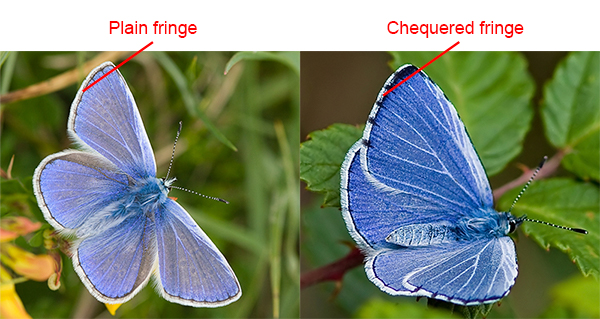
Of the two sexes, it is the female Common Blue that causes most confusion with the Northern Brown Argus. The blue present in a female Common Blue is highly variable, with individuals ranging from almost completely blue through to completely brown. It is this latter colouring that causes the most confusion. Even so, the Northern Brown Argus has no blue scales, but may give off a blue sheen from the wings and the hairs found on the thorax and abdomen. Another diagnostic is that the Northern Brown Argus normally has a prominent dark spot in the centre of the forewings and, in the case of the artaxerxes subspecies, is a distinctive white dot. Any identification challenges are usually, therefore, with respect to the salmacis subspecies of Northern Brown Argus that does not have this white spot.
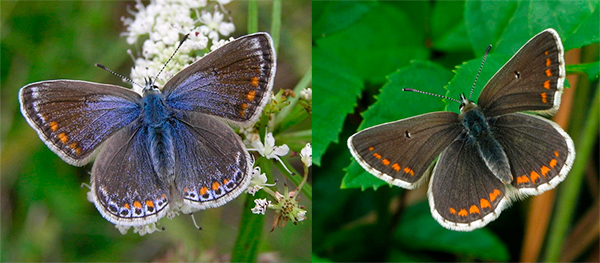
Differentiating Common Blue and Northern Brown Argus from their undersides is more problematic, and we need to resort to the pattern of spots. Here we have two distinguishing features. The first is that the Common Blue has a spot on the underside of the forewing that is absent in the Northern Brown Argus. The second is that two of the spots on the leading edge of the hindwing are relatively-close in the Northern Brown Argus, almost forming a "figure of eight", but are more spaced apart in the Common Blue. This diagnostic is particularly useful if the underside of the forewing isn't visible.
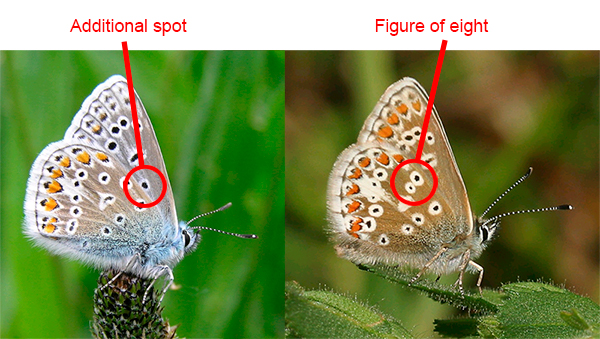
In terms of appearance, the Cryptic Wood White and Wood White can only be differentiated by a detailed examination of their genitalia. Fortunately, we can infer a given species based on location, since the Cryptic Wood White is only found in Ireland where it is widely distributed, although is absent from The Burren in the west, where the Wood White is found.
The Dark Green Fritillary and High Brown Fritillary are most easily distinguished by their undersides, since only the High Brown Fritillary has a row of "ocelli" just inside the outer margin. In addition, as the name suggests, the High Brown Fritillary has a predominately brown hue to the underside, whereas the Dark Green Fritillary is predominately green.
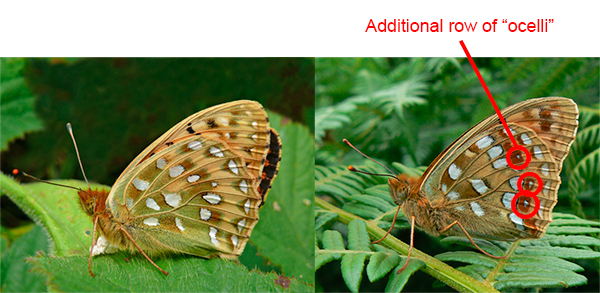
It is much more difficult to distinguish the Dark Green Fritillary from the High Brown Fritillary based on their uppersides. However, the first row of dots from the outside edge of the forewing upperside do give a clue - the 3rd dot from the apex of the forewing is in line with the other dots in the Dark Green Fritillary, but indented toward the body in the High Brown Fritillary.
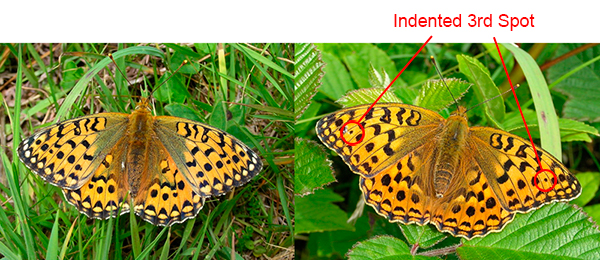
Essex Skipper and Small Skipper can be distinguished by the colour of the underside of the tips of the antennae. In the Essex Skipper, this area is black and in the Small Skipper it is brown. This holds true for both sexes.
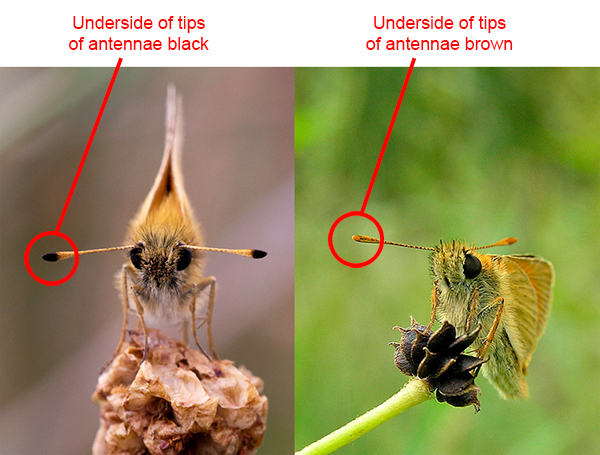
Males can also be distinguished by the sex brand found on the upperside of their forewings. The sex brand of a male Essex Skipper is relatively short when compared with that of the male Small Skipper. The sex brand of a male Essex Skipper also runs parallel with the leading edge of the forewing, but at an angle in the male Small Skipper.
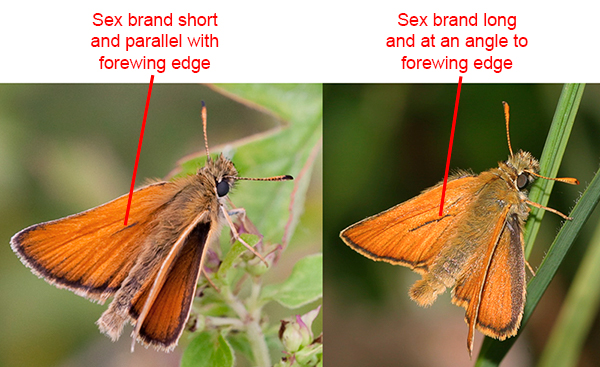
The Green-veined White and Small White are most easily distinguished by their undersides, where the Green-veined White has pronounced markings along the veins which are absent in the Small White.
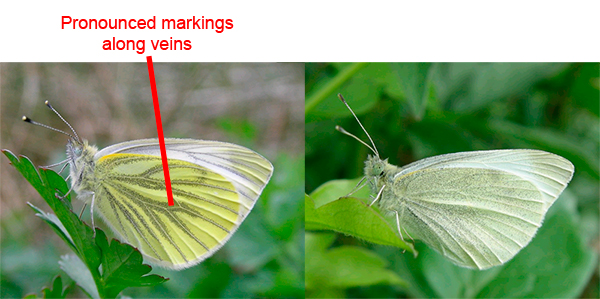
It is much more difficult to distinguish between the Green-veined White and Small White based on the upperside, since the amount of marking is highly variable. In general, the veins of the Green-veined White are more pronounced. Also, the marking at the apex of the forewing of a Green-veined White often extends down the along the edge of the forewing and is not contiguous. The marking at the apex of a Small White never extends down the edge of the forewing and is unbroken.
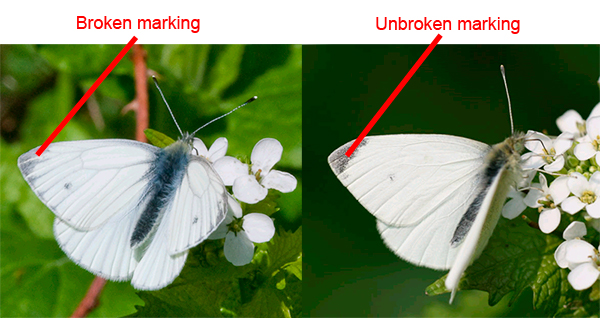
The eye spots found on the underside of the hindwings of the Large Heath are usually enough to distinguish it from the smaller Small Heath. However, the scotica subspecies of Large Heath is largely devoid of spots and in order to distinguish the two species it is necessary to resort to size, since other diagnostics are subtle and not always reliable.
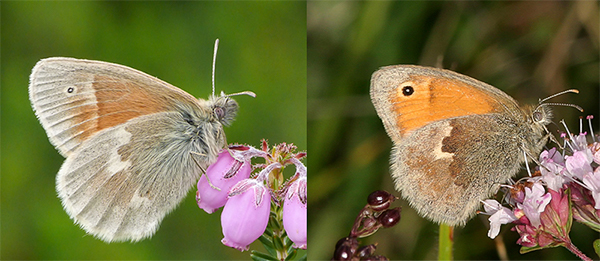
There are several diagnostics that allow a Large Tortoiseshell to be distinguished from the Scarce Tortoiseshell, although there is some variation within each species, and it is therefore necessary to apply a combination of factors when confirming ID. These diagnostics are a) that the black border on the forewings is narrower in the Large Tortoiseshell, b) there is often a yellow area between the black and orange areas on the hindwing of the Large Tortoiseshell whereas the black area on the hindwing is often a continuous band in the Scarce Tortoiseshell, and merges into the orange and c) that the light markings on the leading edge of the forewing are much lighter (almost white) in the Scarce Tortoiseshell.
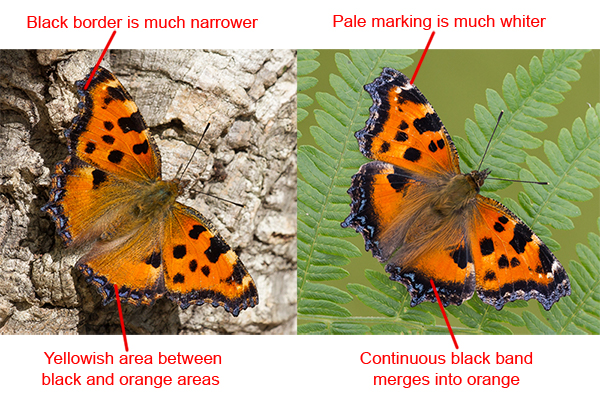
If the underside is visible, then it is clear why the Scarce Tortoiseshell has the alternative vernacular name of Yellow-legged Tortoiseshell, since its light brown legs are much paler than those of the Large Tortoiseshell.
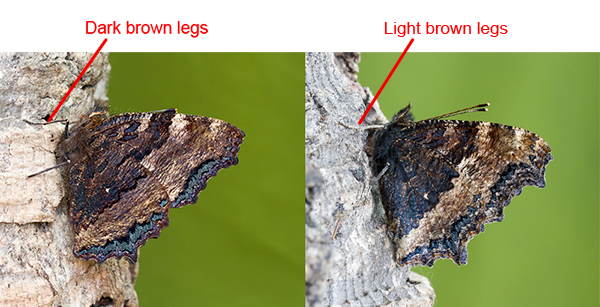
Given their respective names, then it should come as no surprise that the Large Tortoiseshell is larger than the Small Tortoiseshell. However, this can be difficult to discern in the field or from a photograph. However, there are three reliably diagnostics that can be applied - in the Small Tortoiseshell, the pale markings on the leading edge of the forewing are the same length as the adjoining black marks, there is one less black spot on the forewing, and the black region extends across the basal half of the hindwing.
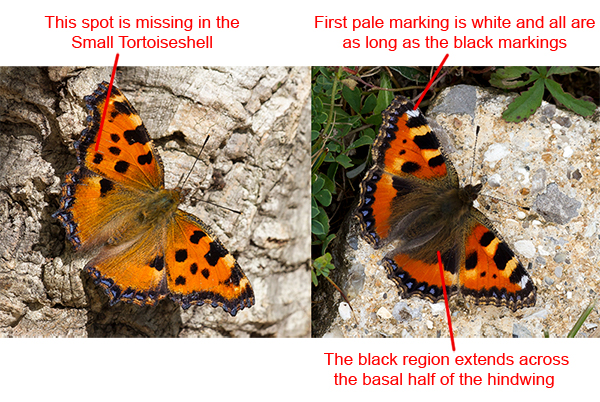
In general, the Large White and Small White can be distinguished based on size. However, there are occasions when a "small" Large White flying with a "large" Small White causes confusion. In terms of uppersides, a distinguishing feature is the black marking at the apex of the forewing. This is generally more vertical than horizontal in the Large White, and more horizontal than vertical in the Small White.
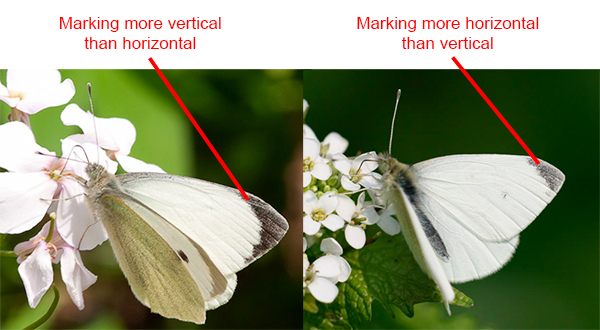
Distinguishing these two species based on their underside is a little more difficult. Aside from size, there is sometimes a hint of the upperside markings where, again, those at the apex of the forewing can give an indication of the species.
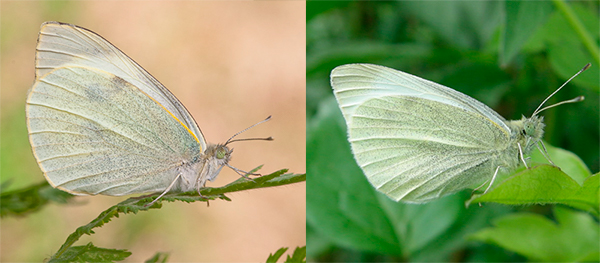
The Pearl-bordered Fritillary and Small Pearl-bordered Fritillary are most easily distinguished by their undersides. Both species have a row of 7 white "pearls" running along the edge of the hindwing (hence their vernacular names). However, the remainder of the underside of the hindwing is quite different. The Pearl-bordered Fritillary exhibits 2 very distinct additional "pearls", whereas the Small Pearl-bordered Fritillary has a mozaic of white, oranges and browns and, as such, has the more colourful underside.

It is much more difficult to distinguish Pearl-bordered Fritillary and Small Pearl-bordered Fritillary based on their uppersides. However, there are two general differences. The first is with regard to the row of chevrons at the edge of the forewings. In the Pearl-bordered Fritillary, these chevrons are often "floating" and not attached to the outer margin, whereas these chevrons are attached to the edge of the forewing in the Small Pearl-bordered Fritillary. The second is with regard to the row of spots found next to these chevrons. In the Pearl-bordered Fritillary, each of these spots is positioned midway between neighbouring markings. In the Small Pearl-bordered Fritillary, the dots are not midway, but distinctly closer to the chevrons.
